The science of the mosses, bryology, knows three main categories of mosses according to constitution and habit. Hornworts (anthocerotophyta), liverworts and bryophytes. The latter are most common. Mosses are non-vascular plants. They adsorb water and nutrients mainly through their leaves. They have a rhizoid only for fixation on the substrate. A water conducting function of the rhizoid is not known. Mosses are suitable as bio-indicator plants. They can take up contaminants and radionuclides directly from the air. Compared to other plants they dispose of a higher surface area. Therefore, there is an ability for accumulation effects. Further, mosses dispose of an active metabolism also in winter. The monitoring of mosses and lichens is well described in literature. Focus in the papers about mosses is on heavy metals, nutrients and air contaminants. Only few papers deal with radio contaminants.
- Moss
- radionuclide
- fallout
- radiocesium
- radiostrontium
- lead-210
1. Introduction
The science of the mosses, bryology, knows three main categories of mosses according to constitution and habit. Hornworts (anthocerotophyta), liverworts and bryophytes. The latter are most common. Mosses are non-vascular plants. They adsorb water and nutrients mainly through their leaves. They have a rhizoid only for fixation on the substrate. A water conducting function of the rhizoid is not known. Mosses are suitable as bio-indicator plants. They can take up contaminants and radionuclides directly from the air. Compared to other plants they dispose of a higher surface area. Therefore, there is an ability for accumulation effects. Further, mosses dispose of an active metabolism also in winter. The monitoring of mosses and lichens is well described in literature. Focus in the papers about mosses is on heavy metals, nutrients and air contaminants [1]. Only few papers deal with radio contaminants.
2. Collection of the Moss Samples
Within the scope of her school leaving examination, Janine Meyer collected 87 moss samples during the summer 2013 in downtown Basel and surrounding villages. She collected the mosses from top of walls, from tombstones, from rooftops, from trees and on the floor. She considered also mosses grown on trees (epiphytes). Janine removed the mosses from the substrate with help of a scraper or by hand protected with gloves.
2.1. Sample preparation
Each moss sample was categorized by a botanist specialized in determining moss varieties. First, the moss samples were separated from earth particles and stones. Then, they were washed with distilled water. Therefore, radionuclides adsorbed on the surface of the mosses were excluded. The samples where dried in an oven at 40°C for three hours and weighed (fresh-weight). Finally, Janine dried the moss samples overnight at 120 °C to determine the dry-weight.
2.2. Gamma spectrometry
Janine grinded the dried moss samples and filled them into petri dishes (6.5 cm diameter, fill height 24 mm). The samples were counted with high-resolution germanium detectors for at least 24 hours. Many samples were reanalysed with longer counting times (up to a week) to lower the statistical error (2s=95%) below 10% for the weak emission line of 210Pb at 46.5 keV. Janine used the following gamma emission energies (with emission probability in %) for identification and quantification of the radionuclides: 7Be: 477.61 keV (10.43), 40K: 1460.50 keV (10.67), 134Cs: 569 keV (15.4), 605 keV (97.6), 796 keV (85.5), 137Cs: 662 keV (84.6), 210Pb: 46.5 keV (4.25), 235U: 143.77 keV (10.94), 163.36 keV (5.08), 185.72 keV (57.0). The gamma spectrometers were efficiency calibrated using a certified 241Am/252Eu-source from the Czech Metrology Institute at Prague. The 210Pb peak was calculated using a single point efficiency calculation at 46.5 keV, produce with the measurement of a 210Pb solution of 70 Bq/L of the same counting geometry. In addition, a careful correction of the density of the moss samples was necessary (to eliminate attenuation effects).
2.3. Beta spectrometry
Radiostrontium (90Sr) was analysed by counting its daughter nuclide, ytttrium-90 (90Y) with means of a gas-proportional a/b-counter. Both radionuclides are in secular equilibrium, when the sample is older than 20 days. 20-50 g of dried moss were calcinated in an oven at 600°C during four hours. Janine dissolved the ashes in 10% HCl and added yttrium chloride (YCl3*6H2O) as a carrier. The she precipitated 90Sr and 90Y with oxalic acid. The precipitates were calcinated at 850 °C for at least one hour. The ashes were dissolved in 20% HCl and strontium chloride (SrCl2*6H2O) added as a carrier. Finally, Janine separated 90Y from 90Sr by selective precipitation of 90Y as yttrium hydroxide. The remaining filtrate, containing the 90Sr, was conserved with hydrochloric acid for further trials if necessary. The yttrium hydroxide was dissolved and precipitated as yttrium oxalate. Finally, the oxalate was separated by filtration over a 2.5 cm diameter Millipore-filter. The precipitate was dried at 35 °C and weighed. Finally, the decay of 90Y in that source was counted by means of a gas proportional a/b-counter LB 4100 from Mirion during three days (10 consecutive runs of 400 minutes each). The main criterion for the purity of the prepared 90Y-oxalate sources was their experimental half-life (theoretically 64 hours) recalculated from the 10 consecutive runs. Almost all moss samples had to be reanalysed twice to thrice due to higher half-lives. The higher half-lives were caused by 210Bi present in the source (originated from the high 210Pb levels in the moss; half-life of 210Bi is 120 hours). After 20 days, 90Y in the filtrate of the first precipitation was again in equilibrium with 90Sr. The analysis of the further trials led to purer sources. Experimental half-lives of 90 hours or less were acceptable.
3. Results
In the following table, moss data are listed as mean activity values ± standard deviation of the pooled samples, collected at the same place.
|
region |
substrate |
altitude (m) m
|
7Be |
40K |
90Sr |
137Cs |
210Pb |
210Pbex |
|
Hüningen, Kleinhüningen |
trees, n=5
|
250 |
640 ± 200 |
1,105 ± 1,690 |
9.3 ± 11 |
19 ± 10 |
450 ± 160 |
445 ± 165 |
|
St. Jakob Park Basel E |
trees, n=7 |
260 |
455 ± 250 |
745 ± 515 |
3.6 ± 2.1 |
11 ± 7 |
335 ± 300 |
330 ± 300 |
|
St.Johannspark Basel W |
trees, n=3 |
260 |
465 ± 270 |
1,990 ± 2,450 |
4.5 ± 0.1 |
11 ± 7 |
190 ± 120 |
170 ± 104 |
|
Park, Basel E |
trees, n=6 |
260 |
310 ± 155 |
1,405 ± 745 |
1.7 ± 1.9 |
19 ± 11 |
390 ± 200 |
355 ± 190 |
|
Lange Erlen Park Basel NE |
trees, n=5 |
260 |
610 ± 245 |
675 ± 600 |
6.0 ± 3.1 |
15 ± 9.3 |
400 ± 300 |
390 ± 225 |
|
Park, Basel W |
trees, n=3 |
260 |
810 ± 320 |
390 ± 145 |
17 ± 15 |
28 ± 9 |
605 ± 260 |
570 ± 255 |
|
Hörnli Graveyard Basel NE |
tombstones, n=10 |
270 |
840 ± 235 |
490 ± 280 |
6.0 ± 8.0 |
14 ± 10 |
705 ± 490 |
695 ± 490 |
|
Hardwald, Wood E of Basel |
trees, n=2 |
274 |
710 ± 70 |
2,145 ± 710 |
8.4 ± 0.7 |
3.7 ± 1
|
340 ± 140 |
310 ± 165 |
|
Graveyard Basel W |
tombstones, n=8 |
275 |
485 ± 135 |
680 ± 540 |
5.0 ± 4.7
|
105 ± 100 |
1,240 ± 565 |
1,210 ± 565 |
|
Rosenfeldpark Basel E |
trees, n=2 |
275 |
650 ± 50 |
490 ± 230 |
---- |
6.0 ± 1.3 |
320 ± 1,510 |
320 ± 155 |
|
SchützenmattparkBasel W |
trees, n=4 |
276 |
148 ± 34 |
1,140 ± 1,040 |
3.7 ± 1.1 |
17 ± 9.1 |
415 ± 185 |
385 ± 155 |
|
Sarasinpark Riehen, N of Basel |
trees, n=3 |
280 |
470 ± 190 |
355 ± 125 |
11 ± 12 |
5.9 ± 0.4 |
505 ± 240 |
495 ± 245 |
|
Graveyard Wolf, Basel S Basel S |
tombstone, n=2 |
280 |
675 ± 365 |
1,335 ± 1,190 |
56 |
18 ±10 |
1,090 ± 390 |
655 ± 160 |
|
Gundeldingen Basel S |
trees, walls, n=4 |
280 |
640 ± 275 |
460 ± 100 |
5.4 ± 3.2 |
12 ± 4.8 |
670 ± 500 |
650 ± 505 |
|
Alpweg Village E of Basel |
roof, trees, n=5 |
350 |
755 ± 560 |
380 ± 290 |
9.9 ± 7.2 |
3.3 ± 2.6 |
1,989 ± 2,574 |
1,890 ± 2,580 |
|
Bruderholz Park Basel S |
trees, n=4 |
366 |
545 ± 135 |
850 ± 595 |
12 ± 7.6 |
10 ± 5.8 |
455 ± 365 |
450 ± 360 |
|
Wartenberg, Hill E of Basel |
trees, walls
|
480 |
750 ± 185 |
1,200 ± 1,385 |
1.7 ± 1.7 |
21 ±12 |
1,210 ± 1,045 |
1,200 ± 935 |
|
Tüllingen, Hill N of Basel |
tree, n=1 |
497 |
170 ± 20 |
265 ± 45 |
---- |
14 ± 0.8 |
63 ± 14 |
51 ± 11 |
|
Chrischona, Hill E of Basel |
tree, roof, n=2 |
409 |
710 ± 410 |
510 ± 320 |
10 ± 6.0 |
28 ± 25 |
1,520 ± 1,275 |
1,510 ± 1,290 |
|
Gempen, Hill SE of Basel |
trees, n=1 |
760 |
800 ± 35 |
1,020 ± 43 |
7.3 ± 1.5 |
88 ± 2 |
467 ± 50 |
371 ± 40 |
Table 1 Summarized Moss data. The moss samples were pooled into 20 groups by their find spots and ranged by the altitude of the find spot. All data are in Bq/kg dry weight (dw). n: number of collected moss samples.
3.1. Beryllium-7 (7Be)
7Be is a cosmogenic radionuclide with a short half-life of 53 days. It reaches the Earth’s surface mainly with wet fallout. Only about 10% are deposed dryly.
Due to its short half-live, the presence of 7Be indicates that the observed material is recent. In older or dead mosses, 7Be would be disintegrated totally.
In all investigated moss samples, 7Be was detectable between 150 and 840 Bq/kg dw This shows that the investigated mosses were not older than two years, and no accumulation process in older material did falsify the found activities.
3.2. Found 210Pb is mainly unsupported lead from the air
210Pb appears at the end of the decay chain of 238U. It has a relatively long half-live of 22.3 Years. Therefore, it is measurable in soils in activities up to 10 kBq/kg dw. This is the so-called supported part of 210Pb, because it is continuously rebuilt in the soil by the disintegration of 226Ra.
Unsupported or “excess” lead-210 (210Pbex)
Part of the built 222Rn leaves the soil by Emanation (evaporation of the gas 222Rn) into the groundwater and the atmosphere. There, 222Rn disintegrates to short-lived daughters and finally to 210Pb, which is adsorbed onto dust particles. The disintegrated 210Pb cannot be rebuilt from 226Ra. The latter is no more present (unsupported 210Pb). This 210Pb is washed out with rain or fallout. The annual fallout flux is estimated to lay between 23 and 367 Bq m-2 y-1 [1]. Lead is strongly adsorbed onto soil particles of the surface layer of the soils. Mosses and lichens adsorb the 210Pbex directly from the air. The total 210Pb-activity is, assuming a secular equilibrium between 226Ra and 210Pb:
Activity (210Pbtot) = Activity (210Pbex) + Activity (226Ra)
Therefore, 210Pbex is calculated by subtraction the activity of 226Ra from the measured 210Pb activity.
Between 90 and 100% of the total 210Pb in moss, originate from 210Pbex, as mosses incorporate 210Pb directly from the air.
3.3. Fallout parameters Radiostrontium and radiocesium
Most prominent fallout parameters are the long-lived radionuclides radiocesium (137Cs) and radiostrontium (90Sr). Even over 30 years after the reactor fire at Chernobyl, these fallout nuclides are present in the environment, even enriched in substrates, such as mosses. The activity range of 90Sr is 2 – 56 Bq/kg dw and for 137Cs 4 – 105 Bq/kg dw. The continuous raise of contaminated dust from soils can explain this phenomenon. The mosses incorporate the radionuclides from dust particles adsorbed on the plant surface.
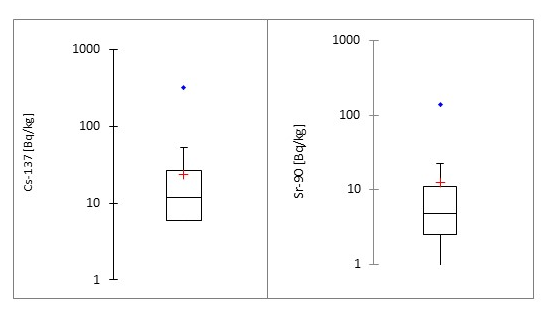
Figure 1. Box plot-distributions of the activities in the collected moss samples (in Bq/kg dw).
Mosses grown on a tombstone at a graveyard in Basel West showed the highest activities of fallout nuclides. The graveyard is situated at the border to France, bordering on open, not built-up fields to the west. This is also the main wind direction in Basel. Mosses (orthotrichum anomalum) on a tombstone showed different activities of fallout nuclides: On the west side of the tombstone, activity was highest: (137Cs: 206±11 Bq/kg dw). Whereas, activity was remarkably lower at the foot of the tombstone in East direction (137Cs: 49±4 Bq/kg dw).
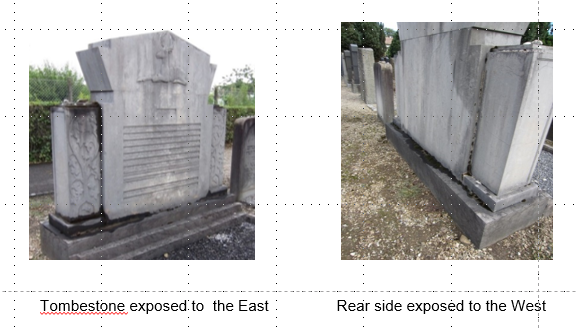
Figure 2. A tombestone showed mosses with different contamination leve.
It seems that exposition to the main wind direction leads to higher depositions of fallout nuclides on surfaces or their accumulation in mosses. In addition, some find spots on hills show higher activities. However, there is no strict correlation between altitude and found activities. There are other factors influencing the degree of the settled fallout, such as sheltering.
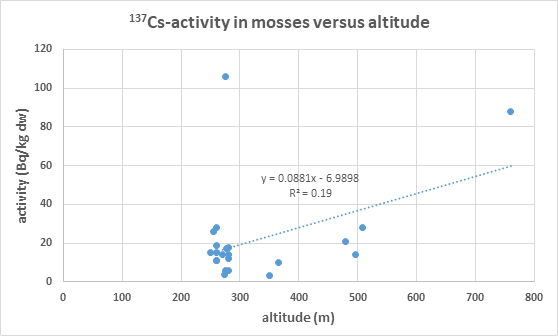
Figure 3. Slight Correlation between 137Cs-activity in moss and the altitude of the find spots.
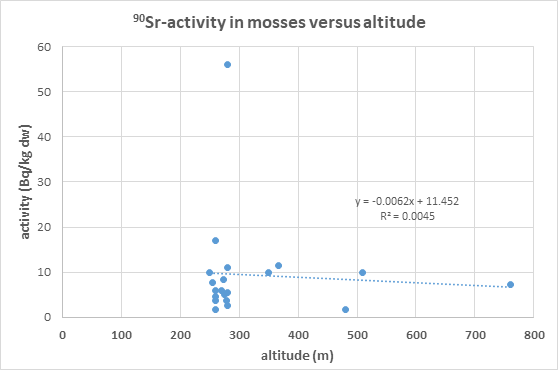
Figure 4. No Correlation between 90Sr-activity in moss and the altitude of the find spots.
Similar results were observed for 137Cs in trees [2].
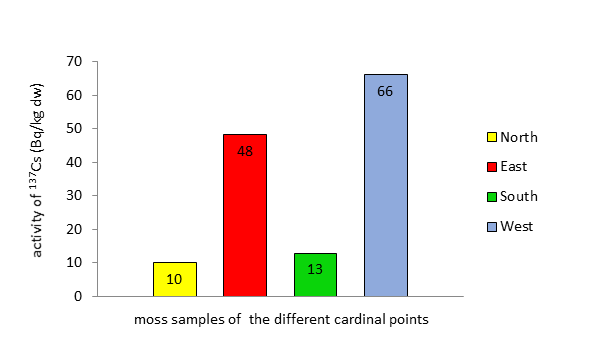
Figure 5. Correlation between 137Cs-activity in moss and the cardinal points. Numbers in columns are percentage of all moss samples.
137Cs-activity in moss samples collected at find spots lying in the principal wind directions in Basel and surroundings, West and East, are significantly higher.
4. Conclusions
Mosses are ideal species for a fallout monitoring. They enrich radionuclides directly from the air. he degree of adsorbed radionuclides into mosses depends strongly on the situation of their find spots. Altitude, degree of sheltering, exposition to main wind direction strongly influence the contamination of mosses.
References
- S. Nickel, W. Schröder. Bestimmung von Schwermetalleinträgen in Waldgebiete mit Modellierung und Moosmonitoring. Schweiz. Zeit für Forstwesen 168 (2017):92-99.
- G. Heinrich, K. Oswald und H. Müller: Zur Kontamination von Flechten in der Steiermark vor und nach dem Reaktorunglück von Chernobyl. Naturwiss. Verein für Steiermark, 1994, 179. www.biologiezentrum.at
